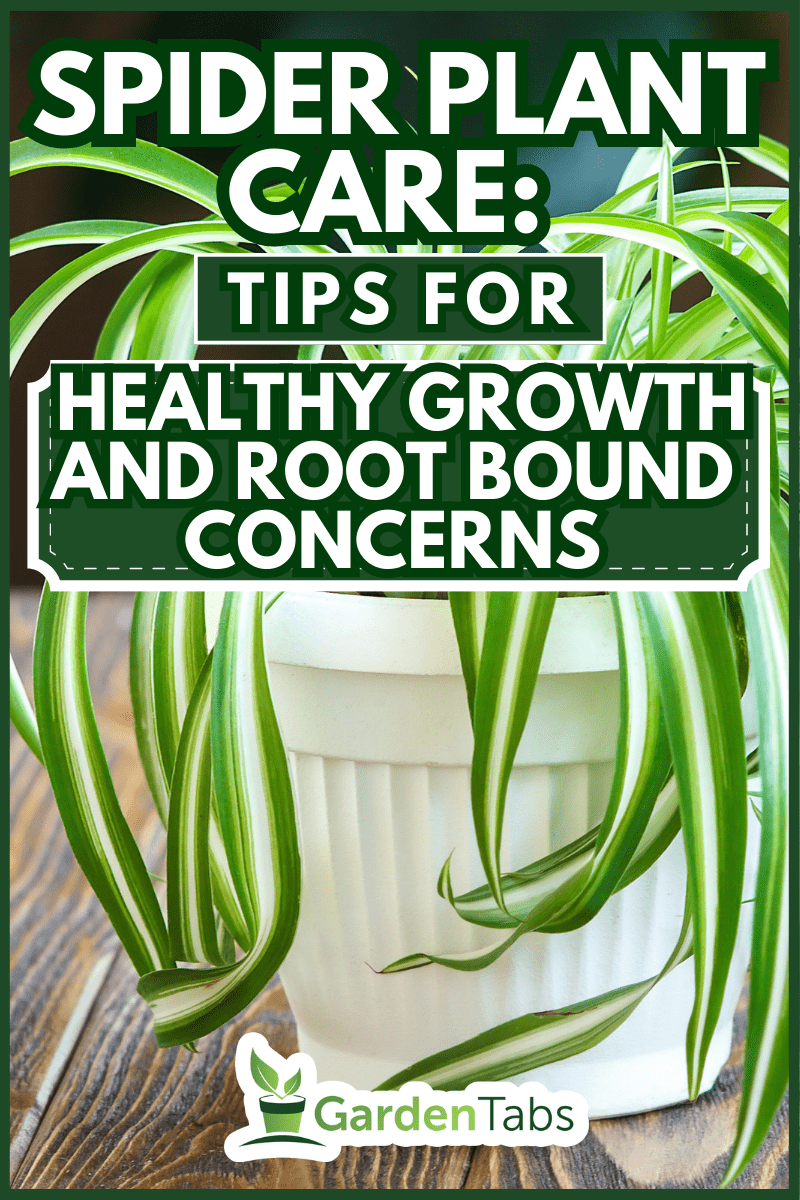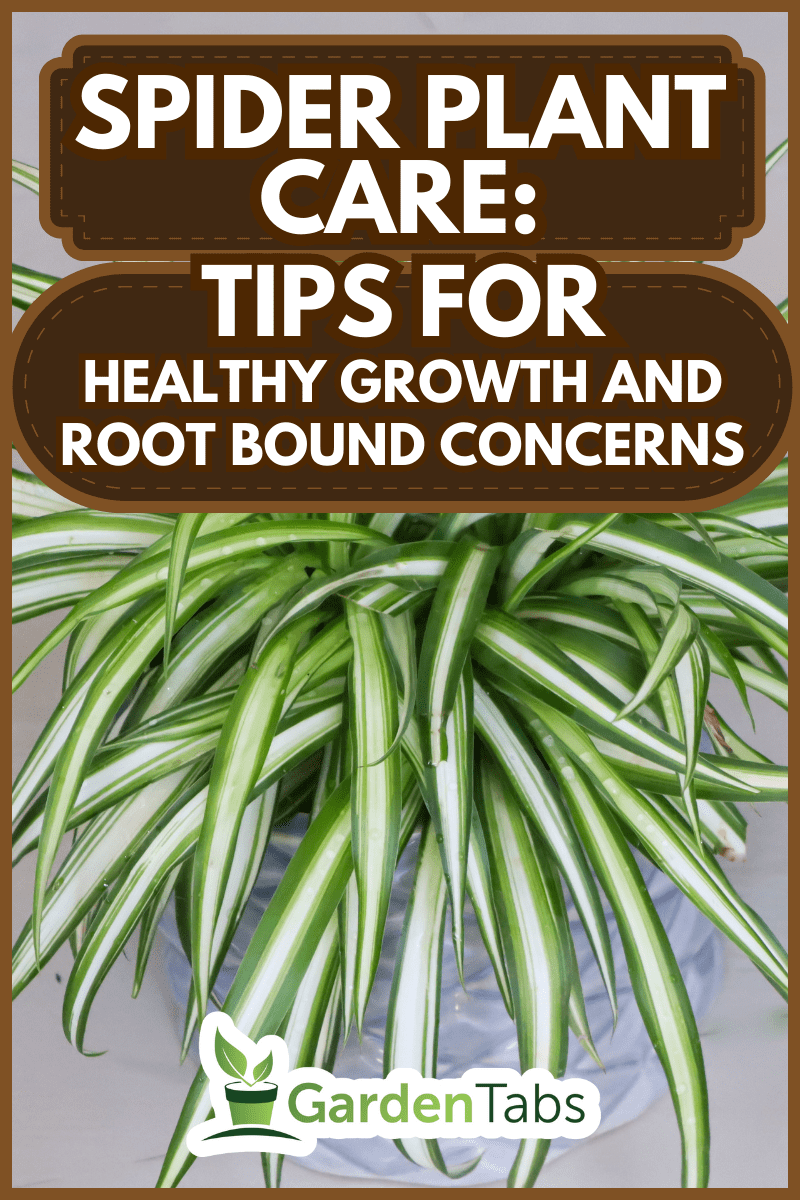Are you ready to take your spider plant game to the next level?
Spider plants are a favorite among plant enthusiasts for their easy-to-care-for nature and adaptability to various environments. However, one question that often arises is whether spider plants like to be root-bound.
Root-bound plants occur when the roots of a plant have outgrown their container. In this article, we will explore whether spider plants like to be root-bound and when to repot them.
Included are tips for healthy growth and care to help you keep your spider plant thriving and looking its best.

Do Spider Plants Like to Be Root-Bound?

Yes, spider plants enjoy being root-bound.
Spider plants tend to outgrow their pots and become root-bound within a year. This condition can trigger even more reproduction.
As long as the roots don't clog the drainage holes, spider plants can stay comfortably root-bound for up to two years before requiring a new pot.
You will need to monitor the plant's growth and repot it when necessary to ensure healthy growth and development.
When repotting a spider plant, choose a pot that has drainage holes to prevent waterlogging. You should select a pot that's one size larger than the current pot.
The pot shouldn't be too large. If it's too large, the soil will stay wet for too long, leading to root rot.
Signs of Root-Bound Spider Plants

Spider plants are known for their ability to thrive in a variety of conditions, including being root-bound.
However, it's important to keep an eye out for signs that your spider plant may be in need of repotting.
Here are signs that your spider plant may be root-bound:
- Roots protruding from the drainage holes.
- Stunted growth.
- Yellow leaves.
- Droopy leaves due to soil drying out quickly.
- Cracked pot.
If you notice any of these signs, you should repot your spider plant.
Repotting will give the plant more room to grow and help it stay healthy and vibrant.
How to Repot Spider Plants

Spider plants should be repotted every one to two years, or when you spot the signs mentioned in the previous paragraph.
The ideal time for repotting is during the spring or summer season when the plant is actively growing.
Steps for Repotting Spider Plants
1. Choose a pot that is larger than the current pot by one size and has drainage holes to prevent water from accumulating at the bottom.
2. Fill the pot halfway up with general-purpose potting soil or soilless medium for spider plants, leaving enough room for the roots to fit comfortably.
3. Gently pull the spider plant out from its current container, being careful not to damage the roots.
4. Take the roots apart gently with your fingers or a small tool like a knife, being careful not to damage them.
5. Place the plant's roots in the soil in the new pot, making sure the plant is centered and upright.
Continue adding soil bit by bit, while gently packing it around the roots until the roots are entirely covered.
6. Water the plant well and allow the excess water to drain out of the bottom of the pot, making sure the soil is moist but not waterlogged.
7. Place it in indirect sunlight.
8. Resume regular care and maintenance, including watering, fertilizing, and pruning as needed.
By following these steps, you can ensure that your spider plant thrives and continues to brighten up your home or office space.
Tips for Healthy Growth and Care
Below are tips for ensuring that your spider plants thrive:
Light Requirements
For optimal growth, spider plants need bright, indirect light. Direct sunlight can scorch the leaves.
While spider plants can survive in low-light environments, they may experience slower growth and limited offshoot production.
If you're growing your spider plant indoors, place it near a north- or east-facing window.
If you're growing it outdoors, find a spot that gets dappled sunlight throughout the day.
Watering Needs

Spider plants like to be kept lightly moist. Excessive watering may lead to root rot and ultimately kill the plant.
You should water your spider plant with rainwater or distilled water. Wait until the top inch of soil is dry, then water the plant thoroughly.
Avoid using tap water, which normally has too much chlorine and fluoride in it. Tap water can cause the tips of the leaves to turn brown.
Discard any excess water in the saucer to prevent the roots from sitting in standing water.
During the winter months, when the plant is growing more slowly, you can reduce the frequency of watering.
Fertilizing Spider Plants
Fertilize your spider plant once a month during the growing season (spring and summer) with a diluted fertilizer solution.
Avoid over-fertilizing, as this can cause the tips of the leaves to turn brown. Try not to under-fertilize because this can lead to weak growth.
Temperature and Humidity
Spider plants do extremely well in temperatures above 50 degrees Fahrenheit.
They also grow well in adequately humid environments, the ideal level being between 40 and 80%.
Low humidity can be detrimental to these plants, causing the leaf tips to turn brown.
Soil Type
These plants can grow in a variety of soil types, but they prefer loose, loam soil with excellent drainage.
The pH of the soil should be slightly acidic to slightly alkaline to prevent the leaf tips from turning brown.
Common Diseases That Affect Spider Plants
Spider plants are generally hardy and resistant to diseases. However, like all plants, they are not immune to certain issues.
Here are some common diseases that spider plants are prone to and how to treat the plants:
Root Rot
The primary reason for root rot in spider plants is overwatering. Soil that is too wet can cause the roots to turn brown or even die.
To prevent root rot, make sure the soil has proper drainage and avoid overwatering.
Powdery Mildew
The hallmark of powdery mildew is the appearance of white patches that transform into yellow-brown spots.
These spots are primarily visible on the upper surface of the leaves.
To curb the disease early on, apply a copper-based fungicide as soon as you notice the spots.
Spider Mites
These tiny pests can infest spider plants and cause the leaves to turn yellow and develop small webs.
To get rid of spider mites, wash the plant with a soapy solution or use an insecticidal soap.
Mealybugs
These pests resemble small, white cotton balls and can cause stunted growth and yellow leaves.
To get rid of mealybugs, wipe the plant with a cotton swab dipped in rubbing alcohol or use an insecticidal soap.
By taking proper care of your spider plant and addressing any issues promptly, you can help ensure that it stays healthy and vibrant for years to come.
Key Takeaways For Repotting And Caring For Spider Plants
If you are a plant enthusiast, you will be happy to learn that spider plants love being root-bound, and it can even encourage reproduction.
You will need to monitor the growth of the plant to avoid stunted development and other issues.
Signs that your spider plant may require repotting include roots emerging from the drainage holes, leaves turning yellow, and pots cracking.
Explore more spider plant posts below:





WOULD LOVE TO HAVE ALL THE INFO.
YOU CAN PROVIDE!
LOVE FLOWER’S & GARDENING!
81 RETIRED LADY!
THANK’S & HAVE A GREAT DAY!